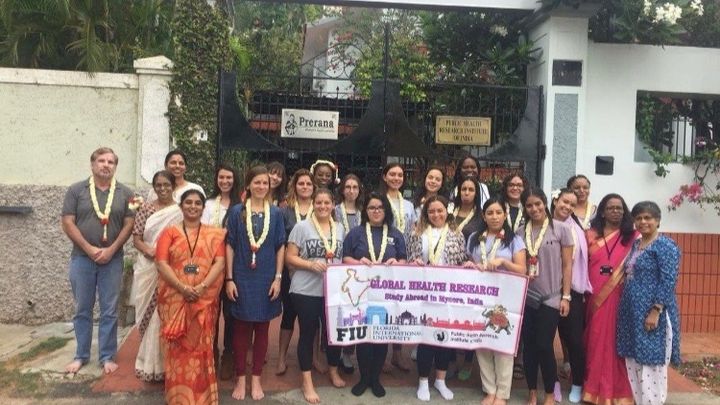
PHRII Cervical Cancer Screening
Cervical cancer contributes to 6-29% of all cancers in women in India and is a major cause of cancer mortality in developing countries (Bobdey,2018,p.278). While the number of women with cervical cancer has greatly decreased in industrial countries, such as the United States, it has not decreased to the same extent in developing countries. A study done by Gopal K. Singh (2012) found that poverty rate, literacy rate, health expenditure per capita, and urbanization were “all significantly related to cervical cancer incidence and mortality” (p.17). Poor living standards in rural areas can be a cause of the large amounts of women with cervical cancer as well. Late-stage diagnosis is also a partial cause for lower cancer survival and higher mortality rates (p.20). This means that it is important to test women as early as possible, but without a nationwide screening program in India, it can become difficult to reach every woman. Another problem when it comes to screening women is knowledge. In a study done by Josephine Jaqueline Mary (2016) it was found 60% of women had poor knowledge when it came to screenings. In order to take action, it is important that communities get educated on cancer screenings and the symptoms of cervical cancer. It is also Important that rural communities in India are given access to screenings, so more women are given the opportunity to be tested.
PHRII travels to different rural communities in India and provides free HPV testing and Pap screenings for infected women. They also offer this in their location in Mysore. PHRII also educates women and communities about cervical cancer, screenings, and symptoms. PHRII is a non-profit and funds these free screenings through donations, fundraising, and assistance from organizations.
It costs $6 dollars for one screening, so for $6 dollars you can potentially save a woman’s life and bring her back to a healthy state.
Sources
Bobdey, S., Sathwara, J., Jain, A., Balasubramaniam, G. (2016). Burden of cervical cancer and role of screening in India. Indian Journal of Medicine & Pediatric Oncology, 37. Retrieved from https://login.proxy.lib.fsu.edu/login?url=http://search.ebscohost.com.proxy.lib.fsu.edu/login.aspx?direct=true&db=a9h&AN=120269615&site=eds-live
Singh, G. K., Azuine, R. E., & Siahpush, M. (2012). Global Inequalities in Cervical Cancer Incidence and Mortality are Linked to Deprivation, Low Socioeconomic Status, and Human Development. International Journal of MCH and AIDS, 1(1), 17–30.
N I, J., Alby, X., Athira, M2., Chinju, J., H A, J. (2016).Effectiveness of STP on Prevention of Cervical Cancer among Married Women in Selected Rural Areas of Kasaragod Dist, Kerala. INT J NURS EDUC, 8. Retrieved from https://login.proxy.lib.fsu.edu/login?url=http://search.ebscohost.com.proxy.lib.fsu.edu/login.aspx?direct=true&db=rzh&AN=116837120&site=eds-live
PHRII travels to different rural communities in India and provides free HPV testing and Pap screenings for infected women. They also offer this in their location in Mysore. PHRII also educates women and communities about cervical cancer, screenings, and symptoms. PHRII is a non-profit and funds these free screenings through donations, fundraising, and assistance from organizations.
It costs $6 dollars for one screening, so for $6 dollars you can potentially save a woman’s life and bring her back to a healthy state.
Sources
Bobdey, S., Sathwara, J., Jain, A., Balasubramaniam, G. (2016). Burden of cervical cancer and role of screening in India. Indian Journal of Medicine & Pediatric Oncology, 37. Retrieved from https://login.proxy.lib.fsu.edu/login?url=http://search.ebscohost.com.proxy.lib.fsu.edu/login.aspx?direct=true&db=a9h&AN=120269615&site=eds-live
Singh, G. K., Azuine, R. E., & Siahpush, M. (2012). Global Inequalities in Cervical Cancer Incidence and Mortality are Linked to Deprivation, Low Socioeconomic Status, and Human Development. International Journal of MCH and AIDS, 1(1), 17–30.
N I, J., Alby, X., Athira, M2., Chinju, J., H A, J. (2016).Effectiveness of STP on Prevention of Cervical Cancer among Married Women in Selected Rural Areas of Kasaragod Dist, Kerala. INT J NURS EDUC, 8. Retrieved from https://login.proxy.lib.fsu.edu/login?url=http://search.ebscohost.com.proxy.lib.fsu.edu/login.aspx?direct=true&db=rzh&AN=116837120&site=eds-live
Organizer
Caileigh Potter
Organizer
Tampa, FL